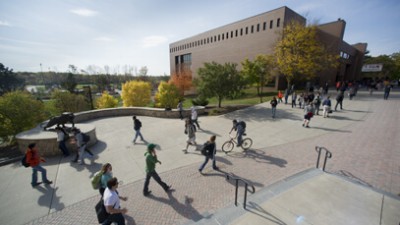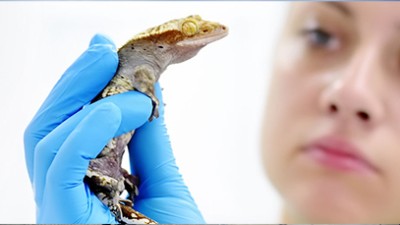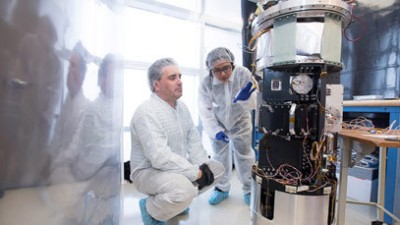News
-
February 24, 2021
![environmental portrait of Guoyu Lu.]()
RIT faculty using smartphones and artificial intelligence to help assess crop roots
An RIT faculty member is creating new artificial intelligence systems that could empower agricultural researchers, breeders, nurseries, and other users to analyze the roots of their crops with the power of their smartphones. Assistant Professor Guoyu Lu is receiving a $450,000 New Investigator grant from the U.S. Department of Agriculture to conduct the research.
-
February 22, 2021
![worker collecting wastewater sample from sewer system.]()
RIT retools its wastewater testing approach for the spring semester
RIT is continuing to refine the way it monitors wastewater to assess the prevalence of coronavirus on campus.
-
February 19, 2021
![Black and white photo of Mars. Headline says Rochester Optics on Mars Rover.]()
Rochester optics on landed Mars rover Perseverance
WROC-TV interviews Michael Richmond, professor of physics and astronomy, about NASA's Mars 2020 Perseverance rover.
-
January 27, 2021
![Butterfly Nebula in deep space.]()
Say Goodbye To 2020 With The Year’s Top 10 Hubble Photos
Forbes features work by Joel Kastner, professor in the Chester F. Carlson Center for Imaging Science and program faculty in the astrophysical sciences and technology graduate program, in its 10 most important Hubble photos from 2020.
-
January 15, 2021
![side-by-side images of the Jewel Bug Nebula using different colors to highlight different areas.]()
Astronomers dissect the anatomy of planetary nebulae using Hubble Space Telescope images
Images of two iconic planetary nebulae taken by the Hubble Space Telescope are revealing new information about how they develop their dramatic features. Researchers from RIT and Green Bank Observatory presented new findings about the Butterfly Nebula and the Jewel Bug Nebula at the 237th meeting of the American Astronomical Society on Friday, Jan. 15.
-
January 15, 2021
![researcher posing on steps in the College of Science.]()
College of Science experiences boom in sponsored research
Several School of Physics and Astronomy faculty secured large grants as principal investigators during a banner summer.
-
January 15, 2021
![researchers wearing clean suits analyzing a magnified view of an integrated circuit.]()
New economy majors connect with emerging careers
Analytical thinking, complex problem solving, creativity, resiliency, and flexibility are among the top skills needed for emerging careers by 2025. Anticipating these rapid changes in the workplace—further accelerated by lessons learned from the COVID-19 pandemic—RIT is seizing on the opportunity to guide students to “new economy majors” that are multidisciplinary, transformative, and future-focused.
-
January 6, 2021
![Graphic of man in gray suit with words: Connections with Evan Dawson.]()
Connections: Is Rochester becoming a hub for the field of textual science?
WXXI’s “Connections” program features Roger Easton, professor in the Chester F. Carlson Center for Imaging Science; Lisa Enochs, second-year student double majoring in motion picture science and imaging science; and Zoë LaLena, second-year imaging science student.
-
December 16, 2020
![large ground satellite.]()
Scientists complete yearlong pulsar timing study after reviving long-dormant radio telescopes
While the scientific community grapples with the loss of the Arecibo radio telescope, astronomers who recently revived a long-dormant radio telescope array in Argentina hope it can help modestly compensate for the work Arecibo did in pulsar timing.
-
December 11, 2020
![professor posing with a LiDAR camera.]()
RIT imaging scientist receives funding to improve how LiDAR can be used to study forests
Imaging scientists at RIT have several new projects in the works to improve the way waveform LiDAR can be used to study forests. LiDAR currently does a good job of outlining the top portion of forests, but by using a more complex form of LiDAR, it can reveal much more detail about what lies beneath the forest canopy’s surface.
-
December 4, 2020
![two researchers testing different lenses.]()
RIT Professor Seth Hubbard receives DOE grant to develop low-cost, high-efficiency solar cells
Professor Seth Hubbard is an expert in designing, growing, and fabricating solar cells and said that if the cost of these highly efficient solar cells can be reduced enough, they could be used to help devices ranging from smartphones to drones to cars.
-
December 3, 2020
![collage of four female chemistry alumni]()
One Mentor, Four Success Stories (and Counting)
It began in 2015 with a research grant, a team of undergraduates, and an outstanding mentor. Today these RIT alumni are developing new cancer therapies, celebrating a patent, writing in science journals, and teaching the next generation of scientists.
















